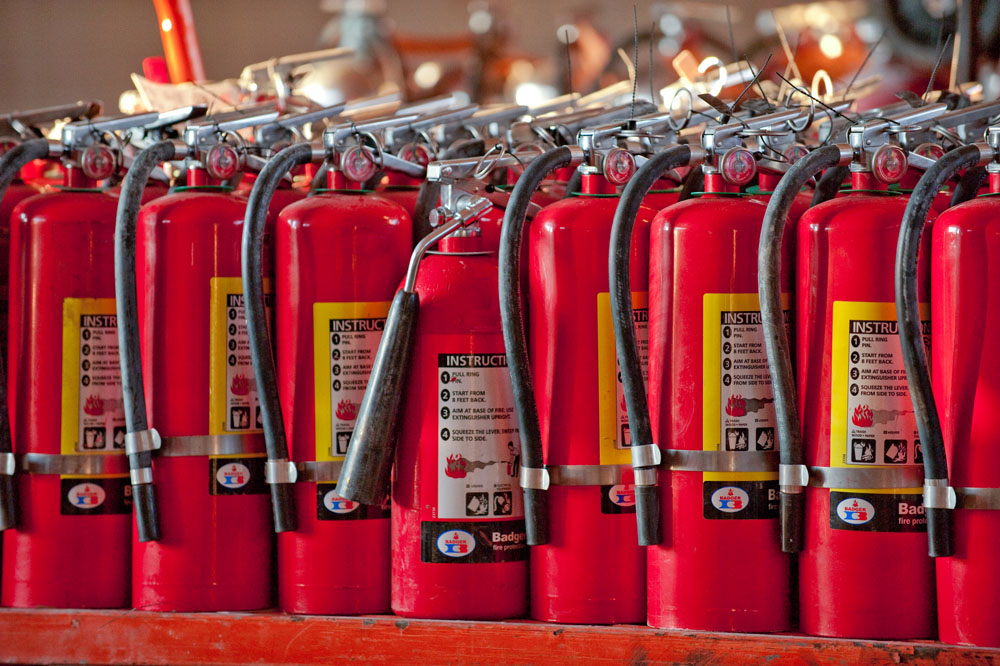A Detailed Look at Fire Extinguishers


Every year, fires caused by cooking, arson, electrical faults, and lightning cause deaths and accidents to humans in addition to damage to property. Because of this, city governments across the US require public buildings and facilities to have firefighting equipment, including fire extinguishers.
Types of Fire Extinguishers
1. Class A extinguishers
Class A extinguishers are used to put out flames fueled by ordinary combustible materials like paper, cloth, wood, and also the majority of plastics. Extinguishers in this class rely on atmosphere pressurized water to put fires out.
2. Class B extinguishers
Fires due to flammable liquids like gasoline, paint, oil, solvents, and grease require course B extinguishers. The main ingredients used to suppress fires in this category are non-flammable gases like carbon dioxide (CO2). It's not a good idea to use water to extinguish fire caused by a flammable liquid.
3. Class C extinguishers
A course C extinguisher can be used to put out fires brought on by electric equipment/gear such as faulty circuit breakers, faulty wiring, fuse boxes, energized electrical parts, and faulty electricity sockets. Since such fires have high danger of electrocution, water-based extinguishers shouldn't be used.
4. Class D extinguishers
Class D extinguisher fight fires fueled by sterile metal powders, shavings, and scents. This description fits chemicals found in many labs like magnesium, potassium, titanium, and sodium.
5. Class K extinguishers
To put out fires which involve combustible cooking fluids like oils and fats, use a course K extinguisher. Since some of the compound agents/compounds utilized to curb kitchen fires are electrically conductive, switch off electricity outlets first. The active agent in this kind of fire extinguisher works by interfering with the chemical reactions that enable fires to continue burning. To use a portable fire extinguisher, aim its nozzle in the source of flame and press on the manage to neutralize compressed agent.

The Importance of Having Fire Extinguishers
To start with, fire extinguishers can save lives if residential or business building occupants place and extinguish a fire during its early stages. Data from the National Fire Protection Association (NFPA) shows that fires in non-residential buildings caused 70 civilian deaths in 2013.
Another benefit of installing extinguishers is to stop fire-related injuries. USFA statistics show that the federal fire injury rate stands 56.2 individuals per one million Americans.
A third advantage is prevention of property damage. NFPA statistics shows that fires caused non-residential property damage worth $2.6 billion in 2013. Thus, the NFPA urges every residential building floor to have one fire extinguisher installed.
Additionally, each extinguisher ought to be installed near a door or emergency exit point. Residential building locations that satisfy this need include front and rear doors since they tend to be conveniently located and readily reachable.
The Importance Of Regular Fire Extinguisher Inspection
Like any other piece of mechanical equipment, extinguishers are prone to failure. For this reason, it's wise to have them inspected regularly by a qualified professional once each month. The inspection process should include:
• Confirming that the extinguisher is observable and accessible
• Confirming the tamper seal is unbroken and the locking pin is intact
• Looking for signs of physical damage such as scratches, leakage, or corrosion/rust on the exterior shell of the extinguisher
• Checking the pressure index and confirming that it is in good working condition.
Fire Extinguisher Servicing
Besides review, fire extinguishers need regular servicing by qualified individuals. This includes:
• Hydrostatic testing with a non-compressible fluid
• Recharging According to review recommendations, or if the extinguisher requires topping up following usage
• Replacement of faulty components that do not function as anticipated
Code Compliance
Portable fire extinguishers sold or installed in buildings in the US must comply with the NFPA 10 standard. This standard is comprised of guidelines on selection, installation, maintenance, review, and hydrostatic testing of extinguishers.
NFPA 10 also includes guidelines on education and training of people who are very likely to handle fire extinguishers in the case of an emergency. In addition, it includes a listing of outdated fire extinguishers that shouldn't be used.
Conclusion
According to the US Fire Administration (USFA), cooking accounts for 49.4% and 29.3 percent of residential and non-residential construction fire episodes. What's more, fires trigger 11 deaths per million Americans annually. To prevent such fatalities and accidents, buildings should have class A, B, C, D, or K fire extinguishers. After every month, extinguishers should experience thorough inspection.